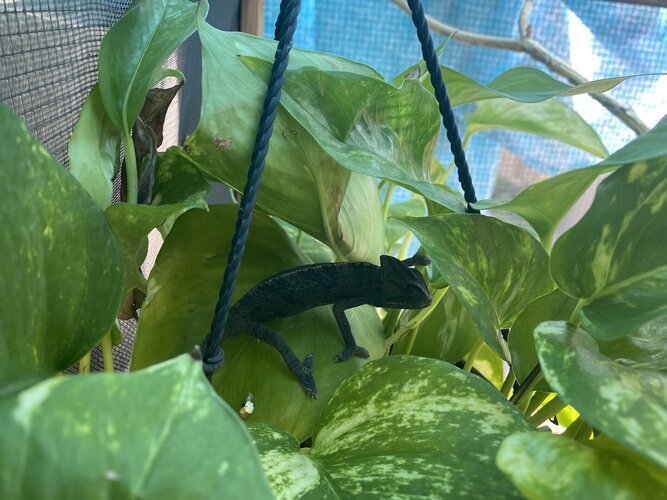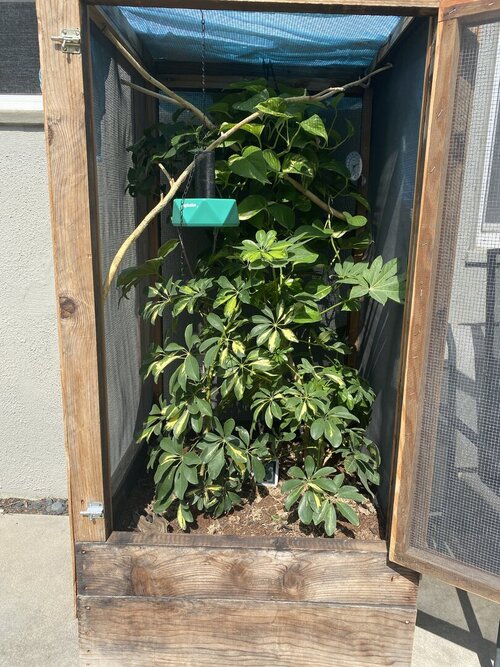Hello,
I have a young (approximately 3-4 month) veiled that appears to be rapidly declining. The stats are as follows:
Chameleon was purchased at Petco (strike one).
The chameleon is housed in a 30" x 30" x 48" outdoor enclosure in Southern California. I've had her for a little more than five weeks. The enclosure is bioactive and is planted with hibiscus, pothos and schefflera. Feeders (small dubias, BSFL, crickets and occasional silks or hornworms are dusted with Earth Pro-A. I do not dust with any D3 due to the outdoor enclosure. The weather since I've had her has been good, with only a couple of days of what I would call high temps (90 degrees). On those days she is brought inside. The average daytime humidity in the enclosure is probably about 30-40, and at night it averages a little over 80. It is beginning to get a bit chilly at night, so at nights I move her into the garage where it doesn't get lower than low to mid 60's. I run a dripper somewhat frequently but have never seen her drink off of leaves or anything like that.
The problem: Last week, she began exhibiting signs of a possible respiratory infection (snout up in the air, gulping open mouth occasionally). She was also not eating from what I could tell. I arranged for a vet visit (tried to get into Dr. Greek but there were no openings, so I went to the vet they suggested I try). The vet said the chameleon appeared healthy, but thought maybe her jaw was slightly softer than what she would like. She also said there might be a mild respiratory issue. They did a blood test, which according to them was normal. They said she was not dehydrated. They did a dewormer, a vitamin shot and also prescribed Baytril to deal with the possible respiratory infection. This all occurred on Friday. Yesterday and today, the chameleon is very dark in color, which is not something she normal exhibits unless basking. She also often has her eyes closed. My hope here is that this current state could possibly be attributed to the medications, but I don't think so. I have a follow up with the same vet on Friday, but have also been trying to get in with Dr. Greek who specializes in chameleons from what I understand.
Any help/advice would be appreciated.
I have a young (approximately 3-4 month) veiled that appears to be rapidly declining. The stats are as follows:
Chameleon was purchased at Petco (strike one).
The chameleon is housed in a 30" x 30" x 48" outdoor enclosure in Southern California. I've had her for a little more than five weeks. The enclosure is bioactive and is planted with hibiscus, pothos and schefflera. Feeders (small dubias, BSFL, crickets and occasional silks or hornworms are dusted with Earth Pro-A. I do not dust with any D3 due to the outdoor enclosure. The weather since I've had her has been good, with only a couple of days of what I would call high temps (90 degrees). On those days she is brought inside. The average daytime humidity in the enclosure is probably about 30-40, and at night it averages a little over 80. It is beginning to get a bit chilly at night, so at nights I move her into the garage where it doesn't get lower than low to mid 60's. I run a dripper somewhat frequently but have never seen her drink off of leaves or anything like that.
The problem: Last week, she began exhibiting signs of a possible respiratory infection (snout up in the air, gulping open mouth occasionally). She was also not eating from what I could tell. I arranged for a vet visit (tried to get into Dr. Greek but there were no openings, so I went to the vet they suggested I try). The vet said the chameleon appeared healthy, but thought maybe her jaw was slightly softer than what she would like. She also said there might be a mild respiratory issue. They did a blood test, which according to them was normal. They said she was not dehydrated. They did a dewormer, a vitamin shot and also prescribed Baytril to deal with the possible respiratory infection. This all occurred on Friday. Yesterday and today, the chameleon is very dark in color, which is not something she normal exhibits unless basking. She also often has her eyes closed. My hope here is that this current state could possibly be attributed to the medications, but I don't think so. I have a follow up with the same vet on Friday, but have also been trying to get in with Dr. Greek who specializes in chameleons from what I understand.
Any help/advice would be appreciated.






